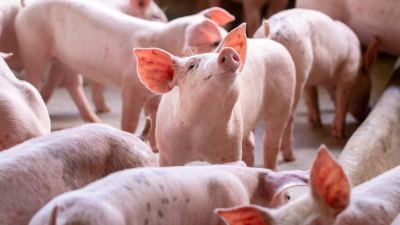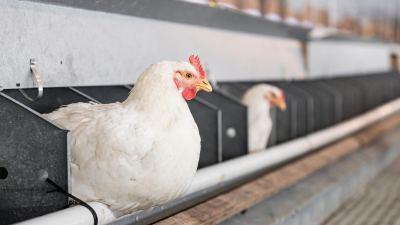The next normal for agri-food

The panelists each used one word to describe the state of their industry right now; McDonald said “chaos” when talking about the dairy industry, Spronk chose “unprecedented” for the pork industry and Wilkinson used “alarming” when citing the figures in the poultry industry.
“We can't say that there's any kind of normalized patterns that we can run by anymore,” said Lynda McDonald, dairy development project manager of Tetra Laval in Africa, in a discussion about the dairy industry in the time of COVID-19 at the Alltech ONE Virtual Experience.
McDonald was the first panelist to speak at “The Next Normal for Agri-Food,” a keynote session moderated by Professor Damien McLoughlin, Anthony C. Cunningham Professor of Marketing at the University College Dublin (UCD) Michael Smurfit Graduate Business School.
McLoughlin capitalized on the panel members’ expertise in different sectors, namely dairy, swine and poultry, to discuss the impacts of COVID-19 on global agribusiness and future implications. Joining the discussion were industry leaders Dr. Gordon Spronk, a vet by training and co-founder of the Pipestone System for pig production in the U.S., and Philip Wilkinson, a senior leader of several global poultry businesses and vice president of the Association of Poultry Processors and Poultry Trade in the EU (AVEC).
The panelists each used one word to describe the state of their industry right now; McDonald said “chaos” when talking about the dairy industry, Spronk chose “unprecedented” for the pork industry and Wilkinson used “alarming” when citing the figures in the poultry industry.
Key takeaways
1. There are similar challenges across agri-food industries due to COVID-19 regarding:
- A change in foodservice demand and consumption habits: A significant volume of out-of-home consumption was lost.
“When restaurants were closed, along with other foodservice entities, due to COVID-19 interventions, that decreased our demand,” said Spronk. According to him, restaurants and foodservice account for about 25% of the demand in the pork industry in the U.S.
Wilkinson estimated that for the poultry industry in northern Europe, that number would be about 20%.
McDonald shared that foodservice and restaurant sales are down 50% for dairy. Remarkably, however, during lockdown and panic-buying, dairy sales have gone up between 50–100%.
“So, it’s a chaotic jump, in terms of the switch from restaurants and foodservice to retail,” she said.
- The level of precision in the food supply chain: Restaurant shutdowns and plant closures due to government interventions created an issue of packaging in dairy, and an issue of weight in swine.
In dairy, pack sizes and the types of dairy people are consuming are changing across the world. This leads to processors not being able to pack what is needed in time. In pig production, the fixed structure cannot handle a certain amount of weight or volume, which can become a safety issue. These issues have led to situations in the U.S. where milk is being dumped and pigs are being gassed or shot, while at the same time, there may be dairy and meat shortages in grocery stores.
This has happened because the system cannot support the demand in terms of market access. Spronk called this an “odd situation,” while McDonald said this is “heartbreaking,” especially considering the food insecurity many people face.
- Storage: Wilkinson mentioned that there are over half a million tons of chicken meat in freezers across Europe right now, and McDonald commented that the number is similar in dairy. She said that there will be about 500,000 tons of dairy going to storage by the end of May, which is comparable to what happened during the last economic shock. These products would typically have gone to foodservice and restaurants.
“At some stage, when we come out of lockdown and get back the new norm, it's still going to take some time for that volume to filter out in the market,” asserted Wilkinson. “This is going to be an 18-month issue, not an 18-week issue. That’s 18 months of price pressure.”
- Export: From a demand-and-supply point of view, McDonald suggested that three risks on the supply side are:
1. Farmers producing less: This can be the result of losing market access, losing credit to purchase feed, labor issues or immigration issues.
2. Governments losing their calm: Some governments are placing export bans on produce.
3. Stockpiling: This risk, when taken into consideration through the lens of exports, impacts traded calories around the world.
Referring to the U.S. swine industry, Spronk explained that 30% of the product is exported. With this in mind, he raised a question: “Do we really want to depend on exports?” He argued that, while the world of globalization says we should, if there is geopolitics at play, that is something producers need to consider.
Wilkinson claimed that, in Europe, there are some businesses and countries whose export policies have been to supply out-of-home consumption, and that is where the problem lies.
2. The moment of truth
Each expert offered their view of what can be learned from what we are seeing during the time of COVID-19. Their insights were that:
- A crisis highlights preexisting problems: “If there's any kind of fragility in the system, any kind of cracks or fissures that were already there previously, a crisis serves to highlight those,” said McDonald. “Many of the dairy systems are robust, functioning well and will continue to function well during this crisis and following.”
- This is an opportunity to learn your strengths and weaknesses: “Mike Tyson once said, ‘Everybody's got a plan until you get punched in the mouth,’” said Spronk. “And so, I'd recommend to any leader in agriculture and in foodservice to lead carefully every day. Never waste a good crisis. Learn what really are the weak and strong points of your team, and build on that.”
- It is harder to adapt when you are overly focused: “Those who are geared up purely to supply out-of-home companies aren’t able to capitalize on the upsurge in consumption from retail,” said Wilkinson. “So, if we find that this is going to be the new norm, countries that are producing high volumes of product are going to have to think again about where their market is or seriously consider looking at another way to utilize their agricultural land.”
3. Challenges present opportunities
- The overall demand for dairy is growing: McDonald argued that, as more people move from subsistence poverty into the middle class in the coming years, one of the first things that they will spend more on is better-quality proteins, including dairy, chicken, pork and beef.
- The poultry sector sees strong growth: “Every problem is an opportunity,” said Wilkinson. He affirmed that the poultry sector could respond quickly because of the short production cycle and because it is a massively consumed meat protein. “We’ve got a meat protein that is an amazing food converter,” he said. “We've got a meat protein that is amazing in terms of water consumption. It doesn't need a lot of space. You can turn it round in six, seven weeks. It is undoubtedly going to be up there in feeding 9–10 billion people going forward.”
- Appetite for local food: In Australia, there is a massive push for local food that is welfare-friendly, traceable and safe. “Australia is starting to move out of lockdown, and out-of-home consumption is starting to pick up there,” said Wilkinson. McDonald also shared that throughout the Muslim world, dairy demand has increased because they are currently in Ramadan. This means that there is a lot more local milk going into informal milk supplies.
- People are starting to return to plants and food services: Even though it will take time to reach full capacity, Spronk’s plants have all reopened. Restaurants that have been closed since the beginning of March are starting to open again as well.
- More testing and the appropriate interventions: Drawing from his veterinarian background and training, Spronk pointed out that swine veterinarians deal with viruses all the time, and it is necessary to run tests. “(Tests) also need to be applied to the communities in general,” he said. “We need to understand who is immune, where’s the virus. Then you can impose the appropriate interventions and let life go on as we know it.”
- A different way of organizing businesses: In China, nearly all production facilities have a dormitory on-site for the staff. Therefore, it is not unusual for staff to stay there for a period of time, which could last for weeks. “In this case, once COVID-19 was announced in China, we still have some farms where the staff has been there since January, before Chinese New Year,” said Spronk.
4. The future is bright for agri-food
Although COVID-19 has exposed problems in the food supply chain, there is hope for the future.
“Nothing's ever hopeless,” assured McDonald. “But it would take strong leadership and strong vision and commitment — commitment to really think about this in a long-term, systematically focused way.”
This means that global collaboration is needed to solve a complex problem with a systematic approach.
“If we just give food aid when these countries (in Africa) are going hungry, we risk disturbing the development of local agriculture,” said McDonald. “So, we're having a negative impact long-term. And we need to be very outcome-focused rather than consequentially focused.”
From a poultry-sector perspective, Wilkinson believes the future is bright for chicken when we get through this, and the industry has got to be better and stronger as a result.
“We will have no doubt whatsoever in feeding 10 billion people,” he said. “It's doable. And we can do it. There are going to be lots of opportunities to grow efficient businesses. There will be further consolidations of the industry. There will be fewer but bigger players. This is going to be an opportunistic time for the lean and the mean to get a bigger presence, particularly in the emerging markets.”
On that note, McLoughlin thanked the panelists for their extraordinary global insights.
“We went from the chaos and destruction of COVID-19 is wreaking in the food supply chain around the world to, I think, a very hopeful message that, in these three supply chains, there is resilience. There is strength,” he concluded. “Whether it's the structure of the European Union business, the character of the U.S. swine industry, the structure and resilience of the global poultry business, this too will pass. There are opportunities for those businesses which are led properly.”















